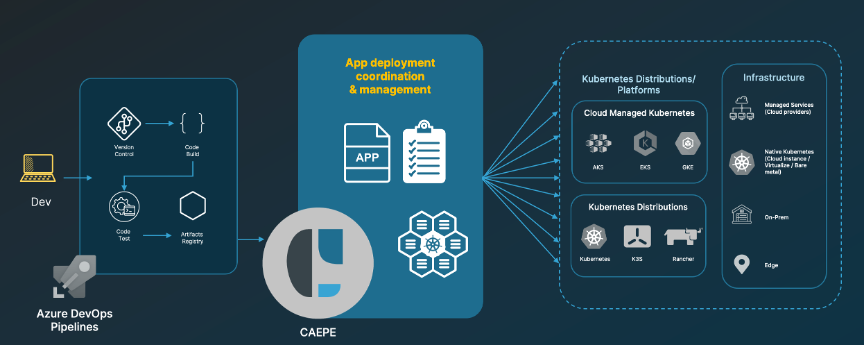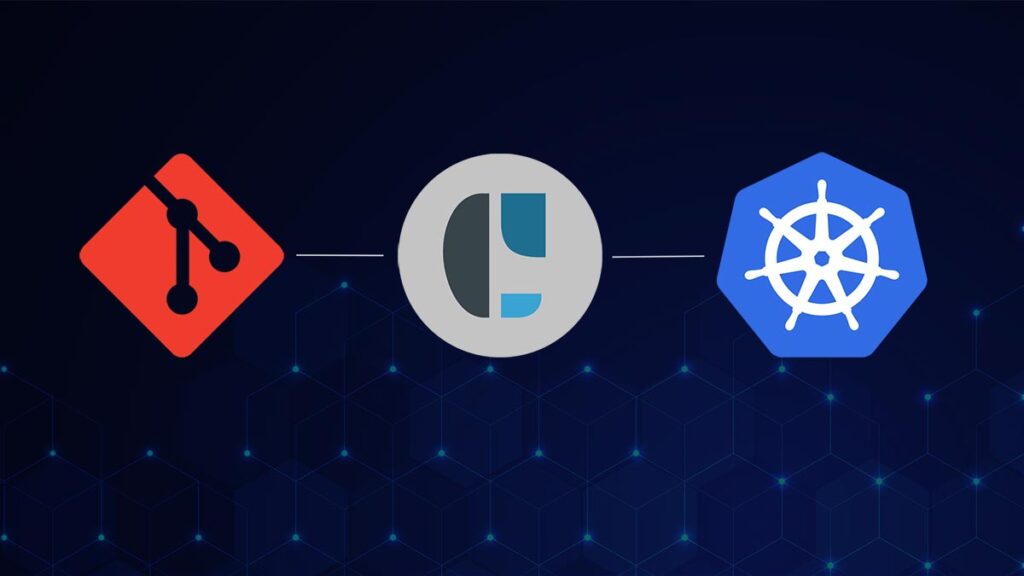Multicloud and hybrid Kubernetes application deployments are on the rise. Organizations are increasingly embracing the flexibility, scalability, and redundancy offered by multicloud approaches, or opting for hybrid setups due to security or regulatory requirements. Hybrid and multicloud scenarios involve deploying containerized applications across diverse environments, each with its own infrastructure and networking complexities. In this article, we’ll discuss how Azure DevOps, in conjunction with CAEPE, can streamline these deployments.
Challenges in Multicloud Kubernetes Applications Deployments
Deploying applications on Kubernetes across multiple clouds introduces several challenges:
Cloud Vendor Differences
Each cloud provider has its specific services and configurations. Adapting Kubernetes applications to work seamlessly across them can be complex, requiring cloud-agnostic coding or custom solutions.
Networking Complexity
Multicloud Kubernetes networking can be intricate due to differing network architectures and policies. Secure cross-cloud communication is a significant challenge.
Data Synchronization
Managing data across multiple clouds necessitates addressing synchronization, backup, and disaster recovery strategies, often requiring specialized tools and meticulous planning.
Resource Management
Consistently allocating and managing CPU, memory, and storage resources across multiple clouds is challenging. Effective auto-scaling policies and resource quotas are essential.
Security and Compliance
Maintaining security and compliance standards consistently across multiple clouds is vital but can be a balancing act due to varying best practices and compliance requirements.
Monitoring and Debugging
Debugging and monitoring become more complex in multicloud setups, necessitating comprehensive monitoring and logging solutions.
Deployment Automation
Automating deployments across multiple clouds requires a robust and flexible automation pipeline that can handle each cloud provider’s nuances.
Updates and Upgrades
Keeping applications and Kubernetes clusters up to date across multiple clouds requires efficient update strategies to avoid downtime.
Vendor Lock-In Mitigation
Architecture and code should allow for switching cloud providers or adopting a multicloud strategy without extensive code changes.
Additional Challenges in Hybrid Kubernetes Applications Deployments
Several challenges from the previous section also apply to hybrid environments. Notable additional challenges are:
Introduction to Azure DevOps
Azure DevOps (ADO) is a cloud-based platform from Microsoft that enables organizations to easily plan, build, test, and release applications. It provides integrated tools and services that support the entire application development lifecycle, from source control to deployment and monitoring. ADO offers features such as continuous integration, continuous delivery, version control, testing and monitoring.
Benefits of Azure DevOps for Multicloud & Hybrid Kubernetes Deployments
Using Azure DevOps for multicloud and hybrid Kubernetes deployments provides numerous benefits:
Unified Development
ADO abstracts complexity, making it easy to apply templates and configurations consistently across different providers.
Automation
ADO abstracts complexity, making it easy to apply templates and configurations consistently across different providers.
Collaboration and Visibility
ADO enhances teamwork with Azure Boards for work planning and Azure Pipelines for clear visibility of deployment processes, promoting collaboration and transparency.
Hybrid Agent Support
ADO supports agents that run both in the cloud and self-hosted.
Artifact Management
Azure DevOps includes artifact management capabilities, making artifact management in hybrid setups more straightforward.
Kubernetes Integration
ADO seamlessly integrates with Kubernetes, enabling effortless deployment and management of containerized applications on Kubernetes clusters. It supports Helm charts and Kubernetes manifest files, making it Kubernetes-native. (If you are using Azure Kubernetes Service (AKS), ADO seamlessly integrates for easy deployment to AKS clusters, whether in the cloud or self-hosted.)
Infrastructure as Code (IaC)
ADO supports infrastructure as code, ensuring consistency in managing Kubernetes resources in hybrid environments.
Scalability and Flexibility
ADO leverages Microsoft Azure’s scalability and flexibility for multicloud Kubernetes deployments, supporting hybrid cloud setups spanning self-hosted and cloud environments.

CAEPE: Simplifying Deployment Management
As a specialized Kubernetes CD tool, CAEPE™ improves ADO’s Continuous Deployment support by offering advanced deployment features not readily attainable in native Kubernetes. It serves as a unified, single tool for managing deployments across various environments, ensuring consistency and quality.
Progressive Delivery
CAEPE provides UI-based workflows for all major deployment strategies including:
- Canary
- A/B
- Blue/Green
- Recreate/Highlander
- Rolling/Ramped
Confident Delivery
CAEPE simplifies both pre and post deployment testing. Pre-deployment tests you can run in CAEPE include Pre-Flight tests and Dry-Runs.
Post-deployment tests you can run in CAEPE:
- Smoke/Sanity Tests
- Performance Tests
- Load Tests
- Stress Tests,
- Chaos Tests and
- Network Connectivity Tests
Deploy Anywhere
CAEPE enables scalable deployments in multicloud and hybrid scenarios with broad cross-platform support, covering major cloud providers, self-hosted edge, and air-gapped scenarios. Its agent works seamlessly in both cloud and self-hosted environments, mitigating vendor lock-in concerns.
Enterprise Features
CAEPE addresses key enterprise requirements, including RBAC/SSO integration, approval workflows, audit management, and maintenance schedules.
Edge / Airgapped Support
CAEPE includes tailored features for no/low-connectivity environments, such as:
- automated cluster builds
- deployment queue prioritization
- estimates for deployment size and time
- private repo/registry management
Universal Access
CAEPE makes deployment management accessible to different developer levels, providing a user-friendly UI, CLI/Scripting, and API options.
By consolidating deployment coordination and management within CAEPE, the CI/CD process becomes more optimized and manageable.
Enhanced CI/CD Pipeline with Azure DevOps & CAEPE
The diagram below illustrates the integration of ADO and CAEPE. Construct the pipeline in ADO that connects to CAEPE. CAEPE can then be utilized to manage all deployment tasks across any environment, including the management of cluster groups, application groups, and maintenance schedules.

Conclusion: Streamlining Multicloud and Hybrid Kubernetes App Deployments
Multicloud and hybrid Kubernetes deployments bring tremendous opportunities and challenges. Azure DevOps (ADO) offers a unified solution to tackle these complexities, providing native Kubernetes integration, automation, infrastructure as code support, and more. Incorporating CAEPE introduces progressive delivery, confident deployment, enhanced support for edge/airgapped scenarios, universal access, and an unprecedented level of deployment optimization and management.
ADO plus CAEPE optimize the CI/CD process, simplifying the intricacies of multicloud and hybrid environments. These tools empower organizations to harness the potential of different environment setups, ensuring the success and reliability of their applications regardless of where they reside.
In part 2 of our article, we will guide you through setting up CAEPE with ADO.

CAEPE Continuous Deployment
Manage workloads on Kubernetes anywhere robustly and securely.
- Shores up security by simplifying deployment anywhere, supporting managed services, native Kubernetes, self-hosted, edge and secure airgapped deployment targets.
- Supports GitOps and provides guided, UI-driven workflows for all major progressive delivery strategies.
- Has RBAC built-in, providing inherent enterprise access control for who can deploy.
- Supports extended testing capabilities enabling your team to run different tests quickly and easily.


